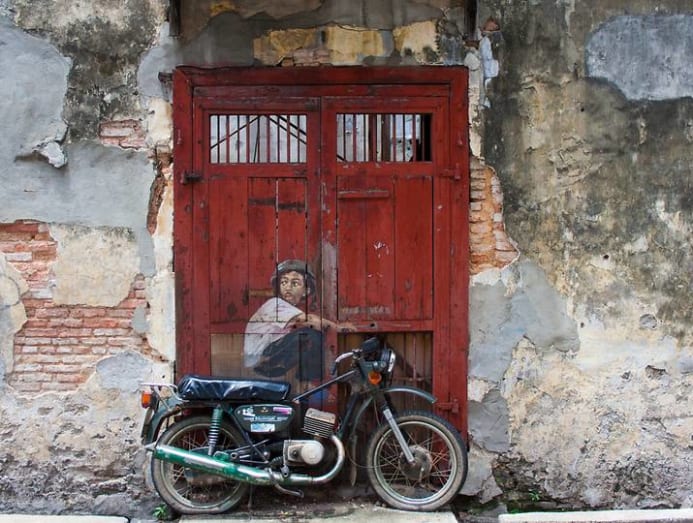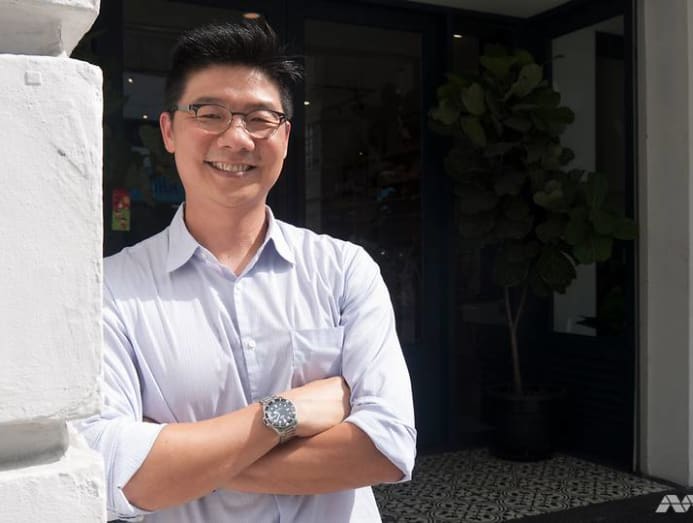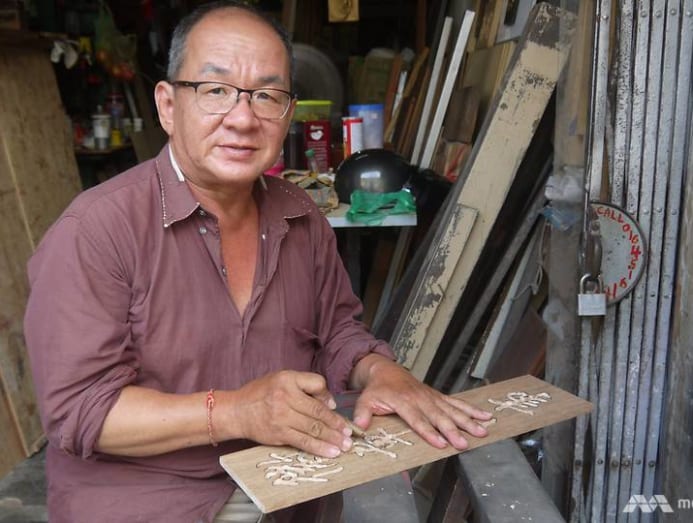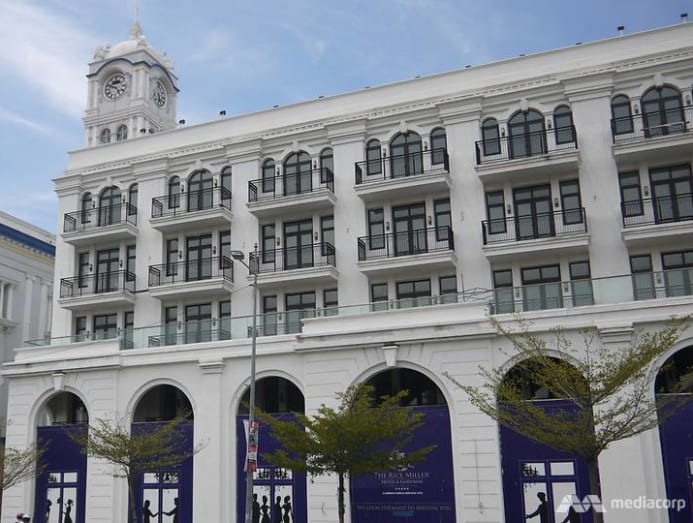George Town in transition: Young people give new meaning to Penang’s heritage district, businesses adapt
GEORGE Boondocks, Penang: As a boy, Mark Ng knew exactly where to observe his shoes if they were stolen.
"The shoes would nearly likely take ended upwards here - this used to exist the Thieves Marketplace," said the 36-year-onetime, pointing at what is at present a manicured park surrounded by Chinese traditional shophouses in the heart of George Town, the uppercase of Penang land in Malaysia.
"Basically it'southward people peddling stolen stuff. And I did find my shoes here!"
These days, the only shady business happening in the area is people taking refuge from the tropical sun on benches under the trees.
Shoes may be safer from theft now, but bigger things are said to take been taken away – the identity and heritage of George Town. Or so it appears in some reports.

It is a tale every bit one-time as time: Tourism ruined everything. Since its list every bit a UNESCO World Heritage Site in 2008, George Town has greeted an influx of tourists.
Property values soared, taking rental rates forth with it. Local residents and businesses unable to beget the pricey rent had to motility out from their homes and shops, taking with them the multicultural heritage and tradition that earned George Town its heritage site condition.
Moving into the vacant lots were new tourist-pandering businesses – lookalike hotels, cafes and souvenir shops. Official data showed that tourist accommodation in the metropolis grew 60 per cent from 2009 to 2013.

However, a stroll downward the heritage city on a weekend told a slightly dissimilar story. While selfie sticks and souvenir stalls did boss a few streets, many others were devoid of tourists.
And the tourist influx may non be the only gene driving changes to the landscape of the old town.
Parts of George Boondocks are evolving, with young people moving into the gentrified spaces and bringing with them new cultural activities.
Meanwhile, business are also adapting and tweaking their product offerings.
'IT'Due south A TREND TO MOVE OUT'
Those interviewed by Channel NewsAsia said the hollowing out of George Town's local population actually happened mode earlier the heritage site listing.
One of the major triggers hitting in 2000, when the Control of Rent Deed was abolished. The city's rental rates shot up between fifty per cent and 300 per cent overnight, co-ordinate to a report by the Khazanah Enquiry Institute in 2017.
George Boondocks'southward inner-urban center cadre had xvi,116 households prior to the abolishment of rent control. Ten years after that, in 2009, the number plunged to only 2,533 households.
Some resented being evicted from their homes of many generations. Merely others were non forced out. They simply traded upward.

Mr Ng, who now runs Merely Enak nutrient tours, moved out of George Town as a child with his family in the 1980s to the shiny new suburb of Fettes Park.
He recalled his excitement to leave the rented shophouse, where his corking grandfather once ran an opium den during Earth War II.
"Final fourth dimension, for most of us growing up hither, we wanted to become out (of George Town). The buildings hither were old."
"These days, they accept septic tanks and indoor toilets. Simply back and so, nosotros didn't have proper sewage in the business firm. I call back and so clearly that the toilet was a big bucket," said the 36-year-old, chuckling at the memory.

Over their bowls of curry noodles at a stall on Campbell Street, photographers Sean Thow and Karen Sim said that they exercise not blame the heritage site listing and the tourism boom for squeezing out traditional trades.
Mr Thow, 68, grew up in George Town, while Ms Sim, 40, photographs traditional shophouses in the city for her work.
They noted that former shops usually stop operating because the younger generation are oftentimes not interested in taking over their ageing parents' businesses, preferring instead to climb corporate ladders or open up trendier cafés and restaurants.
YOUTH SERUM
While old fourth dimension residents have moved out, young Penangnites take stepped up to rejuvenate the area and give it new meaning.
Immature people are now seeing opportunities in the ageing city, co-ordinate to Ms Chen Yoke Pivot, who produces and manages arts and cultural teaching programmes for a non-turn a profit organisation in George Town.
She sees new blood trickling into the space to beginning heritage conservation and inquiry efforts, arts and cultural projects, or entrepreneurship.
This, she notes, is cheers to the new investments, grants and media attention riding on the "glamour" of the heritage site recognition.

According to Ms Chen, governmental and not-governmental organisations set up following the heritage site listing are also facilitating cooperation between the newcomers and older residents to put together community events or detect solutions for shared problems.
"I believe the culture of a place should evolve with immature people coming in. A location only becomes a place if there are people in it, communicating with each other, and changing with the times according to what anybody needs or no longer need," said Ms Chen.

Mr Tan Shih Thoe, an investor who owns and rents out properties in George Town, agrees that young people are creatively reactivating spaces that have long stood lifeless.
He gave the example of Hin Bus Depot, which was a lx,000 square feet of derelict space when he had acquired it.
Since transforming it to a creative hub for young artists to showcase their piece of work, Hin Charabanc Depot is now a hip place to visit. It is ranked 12th out of the 118 things to exercise in George Town on TripAdvisor.
Mr Tan notes that his properties around the expanse are also benefiting from the new menses of foot traffic.
The heritage site status drew immature entrepreneurs to fill his long-vacant lots. "At the end of the twenty-four hours, we desire George Town to be a place where locals tin can build a thriving business, be it a kopitiam (traditional Chinese coffee shop) or a café," he said.
Efforts to renovate historical temples and shophouses since the heritage site listing have improved the aesthetics and condom of the properties.
Any restoration or renovation piece of work on these pre-war properties are under strict government guidelines to preserve historicity, which can jack up the toll significantly. This in turn, drives upwardly rents.

Dr Ang Ming Chee, general manager of the state heritage bureau George Town Globe Heritage Incorporated (GTWHI), pointed out that although holding owners are often upwards in artillery about the plush restrictions, nearly of them still comply.
A survey by the agency in 2022 showed that but one per cent of the heritage buildings in George Town remained battered.
EVOLVING Business concern MODELS
Within these spruced up bounds, is George Boondocks amalgam annihilation that lasts?

Mr Lee Teik Chye, a craftsman who carves signage on Lebuh Acheh (Acheen Street), has his reservations.
Working on a piece of wooden plaque outside his cramped shop, Mr Lee said – in a slightly raised voice over the din of renovation beyond the street – that he sees enough of new businesses around him crop up, merely to close downwards before long later on.
Paying a rental charge per unit that has spiked 200 per cent since the heritage site list, the 63-yr-one-time pointed out that most of his peers in the craft trade had left George Town every bit business was too slow to pay for the high rent.
"Out of every i,000 tourists nosotros become, in that location are probably less than 10 purchasing traditional crafts like mine. Last twelvemonth, I went through iv months with zero income. I'd say that the UNESCO recognition did not aid me much," he said.
The craftsman switched from carving large signage to focus on smaller ones that tourists can easily take domicile in their baggage. "This is business organisation. The ones who tin can adapt to alter, prevails."
Mr Perumal Yalumalai, the possessor of Kalaivanis Volume Centre in George Boondocks'due south Petty Republic of india, besides saw his rental rates rising.
According to the 69-year-quondam, the charge per unit has increased from RM400 (United states$98) per calendar month in 1993, when his shop first opened, to RM5,000 today. Unfortunately, book sales are dwindling.
Similar Mr Lee, Mr Perumal adapted. He began selling a plethora of appurtenances from religious items to musical instruments to souvenirs, which drew the tourists.
Yet profits from tourist traffic are often cancelled out by the steep hire. The George Boondocks dream is slowly losing its sheen.

"I don't meet a golden rush to George Town these days. Vacant lots are being taken upward, but not that apace. We run across new businesses pop up, but nosotros likewise run across quite a few closed for good," said Mr Joachim Leong, who had opened the café Ome by Spacebar Coffee in the city a little over a year ago.
Mr Leong and his partner, Ms Shean Tan had thought that tourists volition be their core customers. Simply it turned out sightseers oft just popped by for an Instagram shot.
The café now depends on local customers – many of whom are increasingly fugitive George Boondocks due to the prevalent impression that it is too congested with tourist-targeted festivals.
Dr Ang of GTWHI said that the authorities desire to ensure that more locals can reap the benefits of the heritage site list.
Her organisation has initiated the George Town Heritage Habitat Seed Fund, which provides financial assistance to heritage building owners to cover the cost of repairing their heritage buildings.
In return, the owners have to sign long-term leases with locals at a cheaper rental charge per unit.

Many, nonetheless, are yet trying to find their footing in the complicated dance between cultural preservation and economic development.
Mr Tan, the property investor, is frustrated by the lack of clarity on what is immune and disallowed when renovating his heritage buildings. "You lot want to follow the regulations, only the goal mail keeps shifting," he said.
Mr Ng's query to state officials on concrete plans to manage tourist flow, which would aid him to plan his food tours without disrupting local lives, went unanswered.
Only there is mutual footing on at least one particular point: George Town is a living economic hub that is not done changing yet.
"Nosotros take to remember that George Boondocks has always been an economic centre of Penang," said Mr Tan, who grew upward on Embankment Street, the urban center'south financial commune.
"Information technology is a place where people exercise business organisation. And businesses take to change and better with the times."
Source: https://cnalifestyle.channelnewsasia.com/asia/george-town-penang-unesco-heritage-culture-222966
0 Response to "George Town in transition: Young people give new meaning to Penang’s heritage district, businesses adapt"
Enregistrer un commentaire